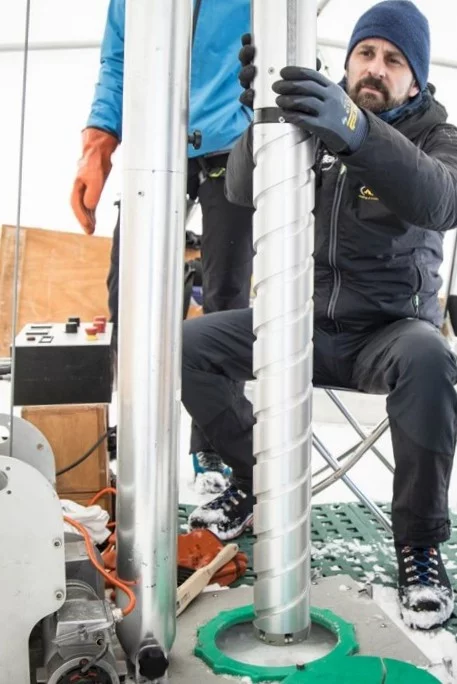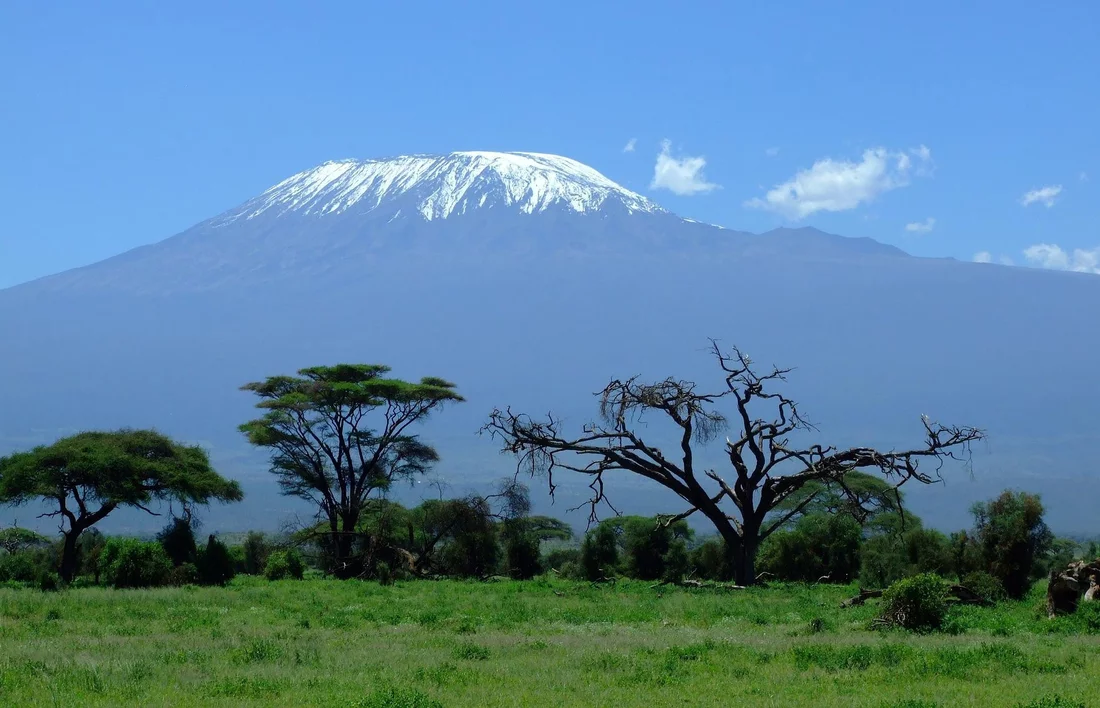The chemist Theo Jenk is a researcher at PSI’s Laboratory of Environmental Chemistry. He regularly takes part in expeditions to glaciers in order to extract and then analyse ice cores. In this interview, he talks about his fascination with ice as an archive of environmental and climate information stretching back thousands of years.
Mr Jenk, what actually is an ice core, and how do you conduct research with it?
Theo Jenk: We extract ice cores from Alpine glaciers or the polar ice caps. We use specialised drills with a hollow drill bit suspended on a winch-operated cable powerful enough to penetrate the ice. Our drills are designed to extract cylindrical ice cores with an eight-centimetre diameter. We use the drill to repeatedly bore into the same hole and extract ice cylinders piece by piece. Each cylinder measures 70 centimetres long to ensure it fits in the insulated boxes we use for transport. Of course, we also keep a strict record of the extraction sequence so we can reconstruct the sections into a complete ice core later on. Wherever possible, our ice core sample extends as far as the bedrock deep below. In the case of high Alpine glaciers, this could well be as deep as a hundred metres or more. Far below, at the bedrock level, sits the oldest ice originating from when the glacier was first formed, with the younger ice layers steadily deposited on top. The information contained in the glacier’s natural archive is precisely what makes it so useful, important and fascinating. It provides a time capsule of past events.
How do you interpret the information contained in this archive?
My specialist area is the dating of ice, partly using radiometric techniques such as radiocarbon dating and mass spectrometry. These allow us to identify trace elements in the ice cores, for example. Ice core research essentially focuses on the isotope composition of the ice itself, its chemical impurities or the particles deposited within it. Many particles expelled into the atmosphere are soon trapped again by precipitation and are deposited back in the ice of that particular region. Alpine ice cores, for example, can tell us when a particular variety of cereal was cultivated on which subcontinent or which metals our ancestors were working with at the time. In some cases, that history can stretch back 10,000 years or more.
So you analyse the ice cores you have collected yourself during expeditions?
For most ice core researchers, these two tasks usually go hand in hand. I am a qualified chemist and have been working at PSI’s Laboratory of Environmental Chemistry since 2012. I probably spend around a quarter of the year planning and running expeditions. I reckon I’ve already taken part in about 15 expeditions, both on high-alpine glaciers and in Greenland. I’ve been expedition leader for some of them, and I’ve physically extracted the ice cores myself many times. My motivation is to learn much more about our climate and our past from these incredible archives in the ice, and to preserve them so the next generation of researchers can continue the work that has fascinated me all these years.
When you say “preserve”, you’re referring to the Ice Memory project, in which PSI is closely involved?
Exactly. The goal of this initiative is to collect ice cores from as many suitable glaciers as possible, across the entire planet, and to store them securely in the Antarctic – before the information they contain becomes useless, or they disappear completely due to climate change. There have been six Ice Memory expeditions to date, three of them led by PSI: 2018 at Belucha in Siberia, 2020 on Grand Combin in Switzerland, and in 2021 a little further to the east on Colle Gnifetti on the border between Switzerland and Italy.
You’ve already warned that the glaciers are melting – so Ice Memory is facing a race against time.
In 2020 on Grand Combin, we originally wanted to bore down to the bedrock 80 metres below, but had to give up after days of trying. Meltwater had seeped through the firn and formed a slush layer with extremely high water content at the boundary between the snow and the ice. Our drill was not designed for this abnormal layering, and got stuck. Melting occurring at over 4,000 metres is a dramatic consequence of advancing climate warming, which surprised and shocked us. Never before had we come across meltwater at this altitude.
But your expedition to Mount Kilimanjaro failed for a completely different reason?
This trip was planned for September 2022. Our technical preparations were excellent. Our plan was to climb to 5,800 metres and extract ice cores over a two-week period. We were confident the problem encountered on Grand Combin wouldn’t be repeated on Kilimanjaro, as the conditions there are very different. When it gets too hot in the Swiss Alps, the surface of the glacier melts to form water. By contrast, no meltwater has ever been observed on Kilimanjaro: because of the strong sunshine and low humidity, the snow and ice evaporate directly into the atmosphere. In the end the expedition failed unexpectedly due to bureaucracy. We applied well in advance for a drilling permit, but unfortunately we did not get permission from the Tanzanian authorities. We were already on site and eventually had to leave empty-handed.
Will there be another attempt to get this expedition off the ground?
We’d certainly like to give it another go. Kilimanjaro’s glacier is extremely important for the local and regional ecosystem, as it is an essential part of the annual water cycle. Around 90 percent of the ice volume has already been lost over the last 150 years or so, and climate change means the ice is expected to disappear completely over the coming decades. This last surviving ice archive in Africa, which cannot be preserved for much longer, is therefore unique – and extremely important for our research community.
It sounds as though you’re facing lots of challenges.
The problem we experienced on Grand Combin threatens almost every glacier. We can get round this by using a different drilling system: a thermal drill that would enable us to get through the ice even under difficult conditions. We didn’t have it with us in 2020 as we had not anticipated such a rapid change in the ice.
So you’ll use this type of drill more frequently in future?
Given the relentless pace of climate change, we will certainly have to use the thermal drill more often. Unfortunately that doesn’t solve all our problems, however: when the meltwater seeps through the ice layers, it washes out the particles deposited in the ice. This totally corrupts the information in the archive and effectively makes it useless. In addition, climate change means that any fresh snow falling on the surface in winter possibly does not survive the following summer. As a result, the ice archive no longer contains any updates – and some layers from previous years may even melt away completely. This will make it impossible for us to date the actual surface of the glacier at the time of drilling, which also creates problems with dating the deeper layers. That makes us even more motivated to collect and safely store as many ice cores as we can, as soon as possible.
Interview: Paul Scherrer Institute/Laura Hennemann
Further information
- Ice Memory Foundation website
- “A race against time”: an interview with Margit Schwikowski, head of the Laboratory for Environmental Chemistry at the Paul Scherrer Institute PSI
Copyright
PSI provides image and/or video material free of charge for media coverage of the content of the above text. Use of this material for other purposes is not permitted. This also includes the transfer of the image and video material into databases as well as sale by third parties.


